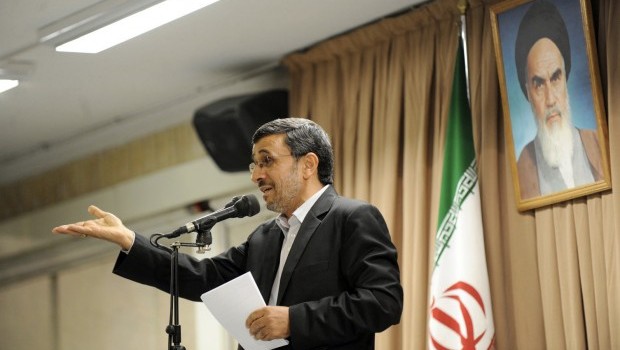
A handout picture released by the official website of the Iranian supreme leader, Ayatollah Ali Khamenei, shows outgoing Iranian president Mahmoud Ahmadinejad speaking during a meeting with Iranian officials at Khamenei’s office in Tehran on July 21, 2013. AFP PHOTO/HO/KHAMENEI.IR)
The report hit most Iranian news outlets on Saturday revealing, and is the first confirmed news regarding what Ahmadinejad’s future after he leaves office on August 3.
The reports dubbed the university the “University of Iranians,” an unusual and patriotic name for a higher education institution.
It is understood that Ahmadinejad had submitted an application to launch the university, and that the council decided to grant the license out of respect for for Ahmadinejad’s unwavering efforts and dedication in his role as head of the council over the past eight years.
The SCRC is in charge of granting licenses for universities, and is presided over by the president of Iran.
Granting permission to establish a new university in the capital stands in clear contradiction with existing regulations, which prohibit the establishment of new universities in Tehran. The SCRC, however, has the authority to overrule such regulations.
The council is comprised of some cabinet ministers, as well as a range of appointees from the supreme leader. A majority of the SCRC’s current members are either radicals or staunch conservatives, and it is possible that some will be removed from the body during the next administration.
In other news, Iranian media reported earlier that the current administration has created a new department within the Presidency organization called the “Office of Former Presidents.” These reports were followed by rumors that a building in central Tehran belonging to the Presidency is being refurbished for Ahmadinejad’s use once he leaves office.
The incoming administration of Hassan Rouhani later denied reports of the new office’s creation, stressing that it had no knowledge of such provision.
Iran is preparing for a handover of power from Ahmadinejad to Rouhani on August 3, and there has been extensive coverage of the transition in the Iranian press.
Last week, the hardline Mashreq News reported from Tehran that part of Ahmadinejad’s personal effects have been transported to his previous residence in the Narmak neighborhood in east Tehran.
The transition is being marked by bitter infighting between radical elements of the principalist faction.
Most notably, there is a growing divide between those principalists who recognize the hardline Shi’ite cleric Ayatollah Mohammed Taqi Mesbah-Yazdi and other principalists who feel his time as the spiritual leader of their faction has passed.
Last week, the Majlis (Parliament) was read a report on the February 10 attack on the speaker of the Majlis, Ali Larijani, in the holy city of Qom. The report implicitly concluded that followers of the resistance front led by Mesbah-Yazdi were responsible for the incident.
The website Ammariyon, which supports members of the radical principalist faction who played a part in the Islamic revolution or who fought in the Iran–Iraq War, has condemned certain statements from members of that resistance front in which they undermined those principalists who did not lend their support to Saeed Jalili.
Mesbah-Yazdi portrays himself as a staunch supporter of the ideals of the Islamic revolution and the principle of velayat-e faqih. However, his detractors state that he has never risked his life for his ideals, whether during the revolution or afterward.
